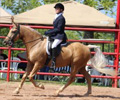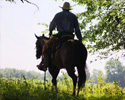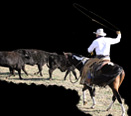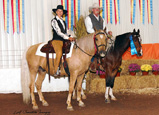Big Barn Ranch Philosophy
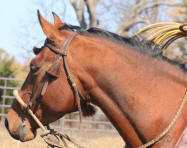 At Big Barn Ranch we have fallen in love with preserving the romance of
the American Cowboy and his horse.
At Big Barn Ranch we have fallen in love with preserving the romance of
the American Cowboy and his horse.
The true origins of Natural Horsemanship lie with the Vaquero who first came to the Americas with the Conquistadors of Spain. A rare breed of horseman who gained knowledge from the Moors after the Morrish conquest of Spain in then 8th century. The Moors were so connected to their horses that they often saw them as family members first, and so they naturally developed a style of horsemanship based on communication, respect and mutual understanding.
This is our philosophy and pursuit at Big Barn Ranch. A philosophy
based on Natural Horsemanship and its origins, Vaquero Horsemanship.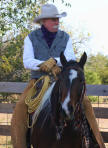
Not tied to one “type” of Natural Horsemanship. We, like the vaquero, “seek to learn from those masters who came before us, and who still enlighten us with what has worked for over a thousand years.”
Waland and Lynne Burger
Purpose
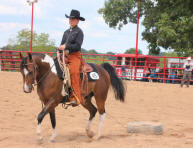 At
Big Barn Ranch we slectively breed Missouri Fox Trotters looking for those
characteristics that define great Versatility, Ranch and Competitive Trail
Horses. We use only the finest bloodlines that lend themselves to
these disciplines.
At
Big Barn Ranch we slectively breed Missouri Fox Trotters looking for those
characteristics that define great Versatility, Ranch and Competitive Trail
Horses. We use only the finest bloodlines that lend themselves to
these disciplines.
Using the example of the original Natural Horseman the Vaqueros and Basic Dessage techniques we start our horses gently and slowly so that they will become willing, polite, curirous, confident and responsive partners.
Training
Many of our foals are imprinted at birth. This imprinting is then followed up with groundwork that begins to instill in them the qualities of politeness, confidence and responsiveness. As weanlings they are introduced to halter, ground work, clippers, vet prep, and are easy to catch.
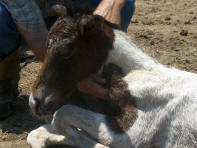 Daily
interaction with each foal continues and as two year olds they are started
under saddle, very lightly ridden and put out to pasture to mature.
Daily
interaction with each foal continues and as two year olds they are started
under saddle, very lightly ridden and put out to pasture to mature.
At three they begin a program which strengthens their bodies, builds endurance and engages their mind.
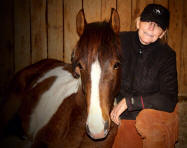 When
you buy a Big Barn Ranch Horse you are not only buying the horse, you are
buying excellent training. Training by the the best natrual horsemen
and experts in their disciplines. We will do our best to ensure that
your partnership with your horse is a good one.
When
you buy a Big Barn Ranch Horse you are not only buying the horse, you are
buying excellent training. Training by the the best natrual horsemen
and experts in their disciplines. We will do our best to ensure that
your partnership with your horse is a good one.
Above: Our Trainer Julie Moore with BBR's Bronx New York New York
Pricing
Our own personal
experience with buying horses is that you can buy a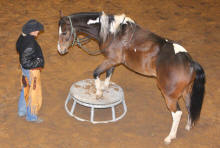 trained horse and know what you are getting, or pay less for your horse,
search around for a proven trainer and maybe you will get good results.
Our trainers are proven and you will not only see the results, you will
ride the results!
trained horse and know what you are getting, or pay less for your horse,
search around for a proven trainer and maybe you will get good results.
Our trainers are proven and you will not only see the results, you will
ride the results!
Vaquero Silhouette
The vaquero first came to the Americas with the Conquistadores of Spain as conquerors and cattle workers, a rare breed of horseman who gained knowledge from the Moors after the Moorish conquest of Spain in the 8th century. The Moors had received their skills from the ancients who first discovered that the horse was not just a means of dietary sustenance, but also, of transportation and later warfare. The Moors were so connected to their horses that they often saw them as family members first, and so they naturally developed a style of horsemanship based on communication, respect and mutual understanding. This was, and is, the true origin of what is now being called “Natural Horsemanship”.
The Spanish, who first rode horses in heavy suits of armor in the La Brida, or stiff legged/stiff bodied style, quickly saw that they were too easily victims of the Moorish flowing La Jeneta, bent legged/free moving style. Thusly, they converted to La Jeneta, threw off their armor and set out to learn the art of communication through horsemanship-to think like their horses. This was the beginning of both European classical equitation (French and Portuguese), and Vaquero style horsemanship – the only difference being the use for which the methods were intended.
Though the vaqueros, like the academy trained horseman of the time, did use their horsemanship skills in combat as well as bull-fights of the rejoneadars, most of the methods were developed for working with cattle which had become the largest industry in the New World. What began as a means of transportation, warfare and industry, became a way of life for the vaquero. Horsemanship and all the skills it entailed, was more than just a means of employment, or a way to move from place to place. When the vaqueros moved north from Mexico to Colonial California, methods that had been handed down from generation to generation took on lives of their own. Life with the horse had become all encompassing – work, art and spiritual endeavor.
The Californios prided themselves on understanding and working with the nature of the horse, and a new culture was forming inside the vaqueros’ world. Many cowboys from Texas and the east moved to California to work on the sprawling ranches, but most “cowboys” were not of the class or caliber of the vaqueros, who would never consider roping a cow hard and fast, or even throwing a calf to the ground. For the Californios, finesse in the saddle, consideration of the animal, the beauty of the sixty-foot loop, the perfection and achievement of extreme lightness in a full bridle horse, meant more than a lifetime’s wages. It was the sensitivity of the Vaquero and his connection to history that helped make him the best reinsman there was, and the cowboys who worked with true vaqueros quickly learned the difference.
Most important to the vaquero was the concept that in training horses, time did not exist. The wild range horses that these horsemen started were not pressured into becoming quick, semi-finished horses. The process they employed – first into the hackamore, then the bosal, then the bosalita, and finally the full spade or half breed bit bridle – could take years to accomplish. But at the end, there was not a horse in the fields lighter than that of the full bridle horse of the vaquero, and to this day, this is still so.
By the end of World War II, many of the big ranches in California and the west were being sold off, and the vaquero was finding it difficult to find work. In the late 1940’s, Master Reinsman and protégé of the Master Reinsman Lupe Lugo, Ed Connell, decided that he needed to put down the methods of this traditional art into print. Much of this information he was dealing with was secretive, handed down directly from father to son, from mentor to apprentice, to forever remain, a secret. But Connell saw firsthand the possibility of the tradition dying out, and so he wrote and published first, “Hackamore Reins man,” in 1949, and then later, “Reinsman of the West.” These would be the only books available on the subject for decades, and are still considered by most vaqueros to be “the truest manuals of Vaquero Horsemanship.”
As mentioned, Vaquero Horsemanship shares its history with other forms of classical equitation, and the connection to today’s “Natural Horsemanship,” is not an accident. Most of the premise of Natural Horsemanship comes directly from the corrals of Vaquero techniques through Californio vaqueros like Tom and Bill Dorrance. Ray Hunt and Master Reinsman, Ed Connell. But much of today’s techniques have been watered down in order to make them appear more “gentle” and “humane.” Yet, the vaquero prided himself in his gentleness, and was such a professional and artist, that those few methods that might now seem harsh were actually more considerate than many of the methods employed today. The difference was that when the vaquero worked with wild range horses, too much gentleness could get the vaquero, or the horse, hurt of killed. And so these methods, handed down for almost 1,000 years, were honed and crafted to be as subtle and gentle as need be.
Today, we see too many students of derivative training systems either undereducated, disillusioned, or even injured, because the true nature of the horse is not understood in an appropriate manner, and so the student is left with a partial concept of what the horse, and horsemanship, is all about. All too often the undereducated student tries to work beyond his/her limitations, and this leads both the horse and aspiring “trainer” on a path toward confusion or worse, simply because the education is incomplete.
The Vaquero has learned from those who have gone before him. As we seek to learn from those masters who came before us, and who still enlighten us with what has worked for over a thousand years.
The vaquero master teaches the apprentice how to paint a silhouette of a vaquero. In time, the silhouette is gone because the apprentice has painted everything around him, and he has become the silhouette. In this way, the vaquero does not train the horse, but take the horse with him up the path toward understanding. In the end, the horse becomes the full bridle horse, and the apprentice becomes the vaquero.
(Author Unknown)

Contact us at Big Barn Ranch if you have questions or comments.
![]()

